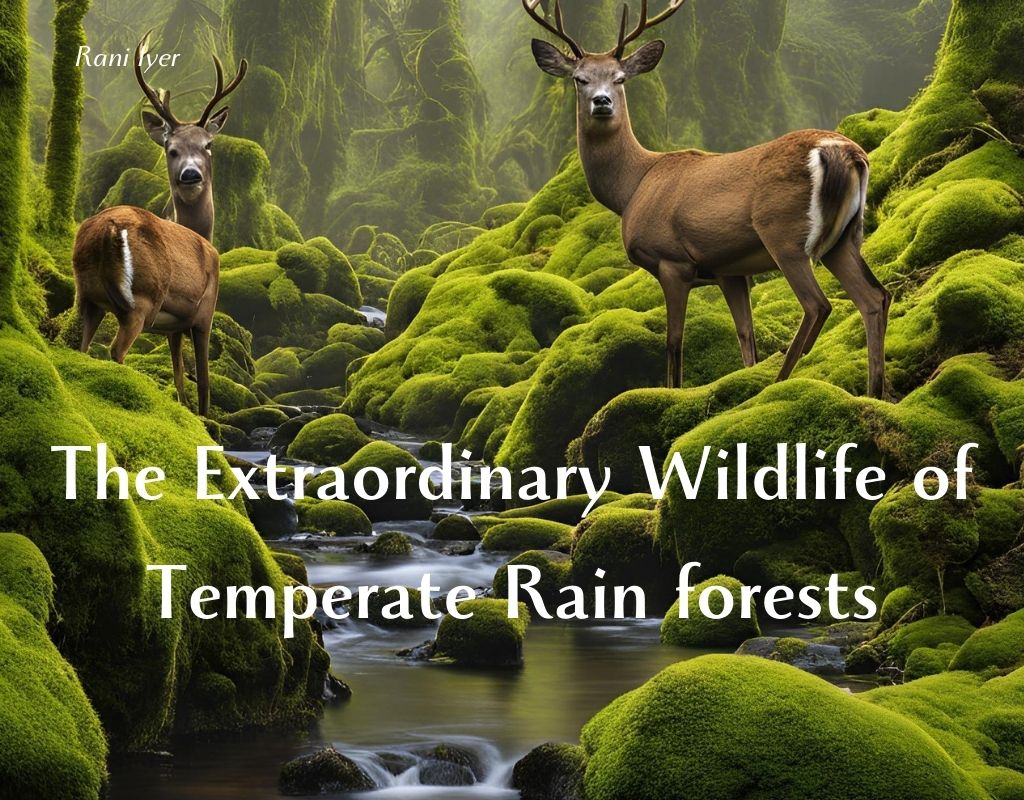Step into the enchanting world of temperate rain forests, where nature’s hidden gems come to life in the most extraordinary ways. With lush green canopies that stretch as far as the eye can see, these pristine ecosystems are home to an abundance of fascinating wildlife. From the towering trees to the forest floor, every inch of this diverse habitat is teeming with life.
Picture yourself surrounded by towering ancient trees, their moss-covered trunks creating a mystical atmosphere. As you wander through the forest, you may stumble upon a majestic elk grazing peacefully, or catch a glimpse of a playful river otter splashing in a crystal-clear stream. The symphony of bird calls above creates a harmonious melody, as vibrant woodpeckers tap away at tree trunks and elusive owls hoot in the distance.
Temperate rain forests are not only a sight to behold but also a crucial ecosystem for countless species. The rich biodiversity of these forests provides habitat for numerous plants, animals, and birds, some of which are found nowhere else on Earth. Join us as we delve into the secrets of temperate rain forests, unveiling the wonders that lie within and revealing why these incredible habitats are worth protecting for generations to come.
Biodiversity in Temperate Rain forests
Temperate rain forests are among the most biologically rich ecosystems on the planet. They boast an impressive array of species, with a staggering variety of plants, animals, fungi, and microorganisms coexisting in a complex web of life. These forests are characterized by their high levels of precipitation, mild temperatures, and a unique climate that fosters the growth of diverse species. The intricate relationships among these organisms contribute to the overall health and stability of the ecosystem.
In temperate rain forests, towering conifers such as Douglas fir, Sitka spruce, and western red cedar dominate the landscape, creating a lush green canopy that supports countless life forms. Beneath this canopy, a rich understory thrives, filled with ferns, shrubs, and flowering plants. This undergrowth plays a crucial role in the life cycle of the forest, providing food and shelter for various animal species. The diversity of plant life not only supports herbivores but also attracts a multitude of pollinators, making these ecosystems vital for maintaining biodiversity.
The wildlife in temperate rain forests is equally impressive. From majestic mammals like black bears and mountain lions to a plethora of bird species, such as the marbled muleteer and the northern spotted owl, these forests are a haven for wildlife enthusiasts. The dynamic interplay between species creates a balanced ecosystem where each organism plays a specific role. The presence of such a wide range of species highlights the importance of temperate rain forests as critical habitats that support ecological diversity.
Unique Flora and Fauna of Temperate Rain forests
The flora of temperate rain forests is not only unique but also incredibly specialized. One of the most striking features of these forests is the presence of epiphytes—plants that grow on other plants without harming them. Mosses, lichens, and ferns adorn the trunks and branches of trees, creating a vibrant tapestry of life. These epiphytes play an essential role in the ecosystem by aiding in nutrient cycling and providing microhabitats for various organisms.
In addition to epiphytes, temperate rain forests are home to a variety of tree species, each adapted to thrive in the moist, shaded environment. The towering trees, some of which can live for over a thousand years, contribute to the forest’s stability and resilience. The rich diversity of plant life supports an equally diverse array of animal species. For instance, the intricate network of roots and fallen logs forms a habitat for small mammals and insects, which in turn attracts larger predators, creating a balanced food web.
Among the remarkable fauna of temperate rain forests are species that have adapted to the unique conditions of this environment. The elusive Pacific tree frog, known for its remarkable camouflage, is just one example of the specialized wildlife found here. Additionally, creatures like the black-tailed deer and the playful river otter thrive in these lush surroundings, showcasing the adaptability of life in temperate rain forests. The presence of such unique flora and fauna underscores the importance of preserving these ecosystems for future generations.
Endangered Species in Temperate Rain forests
Despite their rich biodiversity, temperate rain forests face significant threats that have led to the endangerment of various species. Deforestation, climate change, and habitat fragmentation are some of the critical challenges that have placed immense pressure on the delicate balance of these ecosystems. Many species that rely on specific habitats within temperate rain forests are particularly vulnerable to these changes, leading to a decline in their populations.
One of the most iconic endangered species in temperate rain forests is the northern spotted owl, which has become a symbol of the conservation movement. This majestic bird depends on old-growth forests for nesting and hunting, and the loss of these habitats due to logging and development has severely impacted its population. Conservation efforts are underway to protect the remaining habitat and ensure the survival of this species, highlighting the interconnectedness of wildlife and their environments.
Another species at risk is the marbled murrelet, a seabird that relies on the old-growth forests for nesting. These birds have faced significant declines due to habitat loss and predation. The conservation of temperate rain forests is crucial not only for the survival of these species but also for maintaining the overall health of the ecosystem. Protecting endangered species requires a multi-faceted approach that includes habitat restoration, legal protections, and community engagement to foster a sense of stewardship for these unique environments.
Ecological Importance of Temperate Rain forests
The ecological importance of temperate rain forests cannot be overstated. These ecosystems play a vital role in regulating the Earth’s climate, serving as significant carbon sinks that help mitigate the impacts of climate change. The dense vegetation and rich soil of temperate rain forests store vast amounts of carbon dioxide, reducing greenhouse gas levels in the atmosphere. This function is essential for combating global warming and maintaining ecological balance.
In addition to carbon storage, temperate rain forests contribute to water quality and availability. The intricate root systems of trees and the presence of diverse plant life help filter pollutants from rainwater, ensuring that streams and rivers remain clean and healthy. These forests also play a crucial role in maintaining local hydrology by regulating water flow and preventing soil erosion. The interconnectedness of these ecological processes highlights the significance of temperate rain forests in sustaining both the environment and human communities.
Temperate rain forests provide essential resources for many species, including humans. They supply timber, medicinal plants, and other forest products that are integral to local and global economies. The sustainable management of these resources is vital for ensuring that temperate rain forests continue to thrive while supporting the livelihoods of communities that depend on them. Recognizing the ecological importance of these forests is the first step toward fostering a deeper appreciation for their preservation.
Conservation Efforts in Temperate Rain forests
Conservation efforts in temperate rain forests are crucial for protecting these invaluable ecosystems and the species that inhabit them. Numerous organizations and governmental agencies are actively working to promote sustainable practices, restore degraded habitats, and advocate for policy changes that prioritize conservation. One of the primary focuses of these efforts is the establishment and management of protected areas, which serve as sanctuaries for wildlife and essential ecosystems.
Community engagement is another vital component of conservation initiatives. Local communities often play a key role in the stewardship of temperate rain forests, as they possess invaluable knowledge about the land and its resources. Empowering these communities through education, sustainable practices, and economic incentives can foster a sense of ownership and responsibility toward preserving the forest. Collaborative efforts between conservation organizations and local stakeholders can lead to innovative solutions that benefit both people and nature.
Moreover, research and monitoring are essential for understanding the health of temperate rain forests and informing conservation strategies. Scientists are conducting studies on species populations, habitat conditions, and the impacts of climate change to develop effective management plans. By utilizing technology and data, conservationists can identify critical areas for protection and restoration, ensuring that these ecosystems remain resilient in the face of environmental challenges. The combination of community involvement, scientific research, and policy advocacy is vital for the ongoing success of conservation efforts in temperate rain forests.
Exploring Temperate Rainforests: National Parks and Protected Areas
Exploring temperate rainforests can be a breathtaking adventure, and many national parks and protected areas offer opportunities to experience these unique ecosystems firsthand. Parks such as Olympic National Park in Washington and Redwood National Park in California are prime destinations for those seeking to immerse themselves in the beauty of temperate rain forests. These protected areas showcase towering trees, vibrant flora, and a rich tapestry of wildlife, inviting visitors to connect with nature.
In Olympic National Park, visitors can traverse a diverse landscape that includes lush rain forests, rugged mountains, and pristine coastlines. The Hoh Rain Forest, with its moss-draped trees and abundant wildlife, is a must-see for nature enthusiasts. Guided tours and educational programs provide insight into the ecological significance of the forest and its inhabitants, fostering a deeper appreciation for this remarkable environment.
Redwood National Park, home to some of the tallest trees in the world, offers a unique opportunity to witness the grandeur of temperate rain forests. The iconic redwoods create a breathtaking canopy that shelters a diverse array of plant and animal life. Hiking trails wind through groves of ancient trees, allowing visitors to immerse themselves in the serenity of the forest while learning about the conservation efforts aimed at preserving this natural wonder.
Captivating Experiences in Temperate Rain forests: Hiking, Wildlife Spotting, and Photography
Temperate rain forests offer a plethora of captivating experiences for outdoor enthusiasts, from hiking through enchanting trails to spotting elusive wildlife. The tranquility of these forests, combined with the rich biodiversity, creates an ideal environment for exploration and adventure. Hiking trails range from leisurely strolls to challenging treks, allowing visitors of all skill levels to enjoy the natural beauty of these ecosystems.
Wildlife spotting adds an exciting dimension to any visit to a temperate rain forest. With patience and keen observation, hikers may encounter a variety of animals, including deer, bears, and a multitude of bird species. The vibrant sounds of the forest, from rustling leaves to melodic bird calls, create a symphony that enhances the experience. Guided wildlife tours can provide valuable insights into the behaviors and habitats of these creatures, enriching the visitor’s understanding of the ecosystem.
Photography enthusiasts will find temperate rain forests to be a paradise for capturing stunning images. The interplay of light and shadow among the towering trees, the vibrant colors of foliage, and the unique textures of moss and lichen provide endless opportunities for creativity. Whether capturing the intricate details of ferns or the grandeur of ancient trees, photographers can create breathtaking visual stories that celebrate the beauty of these extraordinary ecosystems.
Sustainable Tourism in Temperate Rain forests
Sustainable tourism is essential for protecting the delicate balance of temperate rain forests while allowing visitors to appreciate their beauty. By promoting responsible travel practices, we can minimize the negative impacts of tourism on these sensitive ecosystems. Sustainable tourism initiatives focus on educating visitors about the importance of conservation, encouraging them to tread lightly and leave no trace as they explore these natural wonders.
Local communities often play a pivotal role in sustainable tourism initiatives. By offering eco-friendly accommodations, guided tours, and educational programs, they can provide visitors with authentic experiences that foster a deeper connection to the environment. This not only supports the local economy but also empowers communities to take an active role in conservation efforts, ensuring that their natural heritage is preserved for future generations.
Moreover, responsible tourism can contribute to the funding of conservation projects and initiatives. Entrance fees for national parks, donations to conservation organizations, and participation in volunteer programs can all support efforts to protect temperate rain forests. By choosing to engage in sustainable tourism practices, travelers can have a positive impact on these ecosystems while enjoying the breathtaking beauty and biodiversity that temperate rain forests have to offer.
Conclusion and Call to Action: Protecting and Preserving Temperate Rain forests
In conclusion, the extraordinary wildlife of temperate rain forests is a testament to the beauty and complexity of our planet’s ecosystems. These unique environments are home to an incredible diversity of flora and fauna, each playing a vital role in the ecological web. However, the threats facing temperate rain forests are significant, and it is imperative that we take action to protect these invaluable habitats.
As individuals, we can contribute to the preservation of temperate rain forests by supporting conservation organizations, practicing sustainable tourism, and advocating for policies that prioritize environmental protection. Every small action counts, and by raising awareness about the importance of these ecosystems, we can inspire others to join the cause.
It is our collective responsibility to ensure that future generations have the opportunity to experience the wonders of temperate rain forests. By working together to protect and preserve these extraordinary habitats, we can help secure a brighter future for wildlife and the planet as a whole. Let us celebrate the hidden gems of nature and commit to safeguarding them for years to come.



